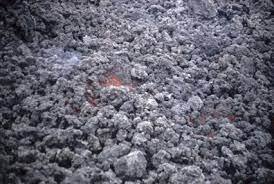Looking down over The Bridge of Flowers and Lights, you will see some of the oldest exposed rock in Vermont. The rock seen at the dam area is known as Tibbits Hill volcanics, a type of metamorphicize basalt.
If you had a time machine and we're looking down 554 million years ago, the water you see below you would be lava; Mafic or basaltic lava, to be specific. This lava type has relatively high magnesium oxide and iron oxide content, generally erupting at temperatures of 1,100 to 1,200 °C (2,010 to 2,190 °F), and has relatively low viscosities. Mafic lava usually has a viscosity similar to school glue, and this less viscous lava can flow for long distances from the vent, or crust opening. When the rock below was lava, it began oozing out when the continents were separating. It spread over a long distance. If fact, this type of basalt rock can be found all over the Missiquoi Valley.
However, not all lava flows the same. Lava can flow great distances before cooling causes it to solidify, because lava exposed to air quickly develops a solid crust that insulates the remaining liquid lava, helping to keep it hot and inviscid enough to continue flowing. There are four main type of lava flow: ʻAʻā, Pāhoehoe, Block lava, Pillow lava.
ʻAʻā is basaltic lava characterized by a rough or rubbly surface composed of broken lava blocks called clinker. The word is Hawaiian meaning "stony rough lava", but also to "burn" or "blaze." The loose, broken, and sharp, spiny surface of an ʻaʻā flow makes walking on the cooled rock difficult and slow. ʻAʻā lavas typically erupt at temperatures of 1,050 to 1,150 °C (1,920 to 2,100 °F) or greater.
Pāhoehoe is basaltic lava that has a smooth, billowy, undulating, or ropy surface. These surface features are due to the movement of very fluid lava under a congealing surface crust. A pāhoehoe flow typically advances as a series of small lobes and toes that continually break out from a cooled crust. The surface texture of pāhoehoe flows varies widely, displaying all kinds of bizarre shapes often referred to as lava sculpture. Pahoehoe lavas typically have a temperature of 1,100 to 1,200 °C (2,010 to 2,190 °F).  D
D
Block Lava behaves in a similar manner to ʻaʻā flows but its more viscous nature causes the surface to be covered in smooth-sided angular fragments (blocks) of solidified lava instead of clinkers. As with ʻaʻā flows, the molten interior of the flow, which is kept insulated by the solidified blocky surface, advances over the rubble that falls off the flow front. 
Pillow Lava is the lava structure typically formed when lava emerges from an underwater volcano or a lava flow enters the ocean. The viscous lava gains a solid crust on contact with the water, and this crust cracks and oozes additional large blobs or "pillows" as more lava emerges from the advancing flow. Since water covers the majority of Earth's surface and most volcanoes are situated near or under bodies of water, pillow lava is very common.
Back to the cache. Looking down we see the ancient lava flow pattern(s) on the side of the walls and on the exposed river bed, After reading the infomtion about lava flow, how did the Tibbits Hill Volcanics flow in the riverbed below when the contential split occurred? Is there evidence of more than one type of lava flow? If yes, what's the other type(s)?
Message answers to C.O. and log. If answers are incorrect, log will be deleted. DO NOT POST ASNWERS. Logs with answers will be deleted.